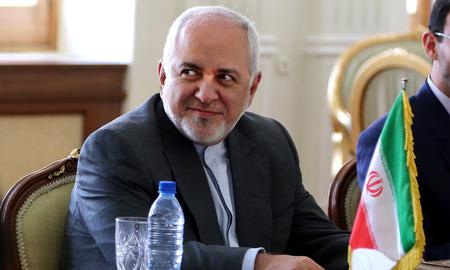In an unusual though not unexpected move, the US Treasury announced on Wednesday, July 31, that it has placed the Iranian Foreign Minister Mohammad Javad Zarif on the sanctions list of its Office of Foreign Assets Control (OFAC) pursuant to President Trump’s Executive Order 13876. The Treasury announced the reason for the move was “because Zarif acted or purported to act for or on behalf of, directly or indirectly, the Supreme Leader of the Islamic Republic of Iran.”
It is the first time since the United States imposed sanctions on the Supreme Leader Ayatollah Khamenei and his office that a senior official of the Islamic Republic has been added to the sanctions list because of his connection to the office of the Supreme Leader. The executive order of June 24 gave the US Treasury the power to sanction any “person appointed by the Supreme Leader of Iran or the SLO [Supreme Leader’s Office] to a position as a state official of Iran, or as the head of any entity located in Iran or any entity located outside of Iran that is owned or controlled by one or more entities in Iran.”
In a statement on Wednesday, July 31, US Treasury Secretary Steven Mnuchin said: “Javad Zarif implements the reckless agenda of Iran’s Supreme Leader, and is the regime’s primary spokesperson around the world.” US Secretary of State Mike Pompeo tweeted: "Recently, President Trump sanctioned Iran’s Supreme Leader, who enriched himself at the expense of the Iranian people. Today, the US designated his chief apologist Javad Zarif. He’s just as complicit in the regime’s outlaw behavior as the rest of Khamenei’s mafia.”
Who Really Appoints the Iranian Foreign Minister?
Officially, the Islamic Republic’s foreign minister is appointed by the Iranian president, but over the last three decades, since Ayatollah Khamenei has been the Supreme Leader, it has become undisputedly clear that a foreign minister cannot be appointed unless he has been approved personally by the Leader himself. Since the start of Zarif’s tenure as foreign minister of the Islamic Republic, which coincided with the official nuclear negotiations between Iran and the United States, the foreign minister himself has repeatedly said that he could not have done it without the support of Ayatollah Khamenei.
From 2002 to 2007, Zarif was the Iranian ambassador to the UN. In his memoirs, which were published a few weeks before his ministerial appointment, he writes that Ayatollah Khamenei approved his ambassadorship to the UN with the support of Ali Asghar Hejazi, the official in charge of security affairs at the Supreme Leader’s office.
Now, more than a month after the US imposed sanctions on Ayatollah Khamenei as an individual, as well as his office and his associates, it has launched its related “designated” list by placing the foreign minister on it. The assets, properties and bank accounts of anybody on this designated list are subject to seizure, and the US had advertised its intention to put Zarif on the list at the same time that it announced sanctions on the Supreme Leader — giving him ample time to remove his assets, if he had any, from the United States.
Zarif has said that he has no assets or bank accounts in the US and after the sanctions against him were officially announced, he reiterated his claim with sarcasm. “The US' reason for designating me is that I am Iran's ‘primary spokesperson around the world,’” he tweeted on July 31. “Is the truth really that painful? It has no effect on me or my family, as I have no property or interests outside of Iran. Thank you for considering me such a huge threat to your agenda.”
In addition to having their assets seized, the designated individuals cannot enter the US or its territories. If they already have been issued a visa, it will be revoked, and if they request a visa they will be refused because they are “on the list.” According to international law, however, foreign ministers enjoy immunity during their tenure. Based on the agreement between the United Nations and the United States as the host country to the UN headquarters in New York, the US must approve the visas of all persons who attend UN missions in New York.
When Foreign Minister Zarif traveled to New York in July 2019 to attend a UN conference, American officials said that Secretary of State Pompeo had personally approved the visa. In an exception to its agreement with UN, the US can refuse visas to anybody whom it considers to be a threat to its national security and, in the case of the Islamic Republic, it has happened once before. In 2014, when Hamid Aboutalebi was appointed Iranian ambassador to the UN, the US refused to issue him a visa because of his alleged involvement in the 1979 takeover of the US embassy in Tehran and in the hostage crisis that followed. Eventually, the Islamic Republic was forced to appoint another person as its UN ambassador.
On a “Case by Case” Basis
Nevertheless, the US has never refused to issue a visa to a foreign minister. After Zarif was put on the sanctions list, spokespeople for the State Department said that his requests for visas would be decided on a case by case basis. Regardless of whether the US will grant Zarif visas in the future or not, what has already happened to Zarif as a foreign minister is unprecedented.
For the last 30 years the US has imposed unprecedented restrictions on members of the Iranian delegation at the UN. Although they have been issued visas, they cannot travel to other American cities and are not allowed to go further than 40 kilometers from the UN headquarters in New York. Recently, the US has further tightened these restrictions.
Less than a month ago, the State Department informed the Iranian delegation at the UN that the members of the delegation, their families and Islamic Republic officials, such as the foreign minister, who come to the UN for a short period of time only are limited to three locations in New York: the UN headquarters, the offices of the Iranian delegation to the UN and the residence of the Iranian ambassador to the UN. The three locations are close to one another and the only exception allowed is traveling to and from JFK Airport when they leave or enter the US.
Iran has submitted a complaint against this decision to the UN secretary general but so far the situation has not changed. The next session of the UN General Assembly is due to start in New York in less than two months and it is likely that the Iranian foreign minister will request another visa to enter the US to attend. If Zarif is refused a visa, he will be the first foreign minister in the world who was not able to visit New York to participate in a UN event. If he is granted a visa, however, he will be the first person in the world who has received a visa to enter the US despite the fact he is on the American sanctions list.
Related Coverage:
Sanctions Against Zarif: How Far Will They Go?, June 27, 2019
Sanctions on Ayatollah Khamenei are Much More Than Symbolic, June 25, 2019
Does Iran Really Want to Negotiate with the US?, June 21, 2019
Decoding Iran’s Politics: The 12-Point US Ultimatum, July 6, 2018
The 12 Demands of Pompeo's New Iran Strategy, May 21, 2018
visit the accountability section
In this section of Iran Wire, you can contact the officials and launch your campaign for various problems



























comments